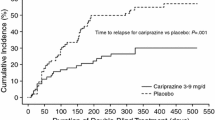Abstract
Sertindole is a non-sedating atypical antipsychotic agent with high selectivity for dopaminergic neurons in the mesolimbic system. In pivotal clinical trials, sertindole has demonstrated significantly greater efficacy than placebo against both the positive and negative symptoms of schizophrenia. In addition, sertindole has had at least similar efficacy to haloperidol and risperidone against positive symptoms, and significantly greater efficacy than haloperidol and risperidone against negative symptoms. The incidence of extrapyramidal symptom (EPS)-related adverse events and the rate of medication used to treat EPS in patients receiving clinically effective doses of sertindole in clinical trials were similar to those observed in placebo recipients and significantly less than those in haloperidol recipients. The incidence of QTc interval prolongation of 500 ms or greater with therapeutic dosages of sertindole has also been low. In general, sertindole has been well tolerated in clinical trials. Unlike other antipsychotic agents, sertindole has not been associated with cognitive impairment, and can actually improve cognitive function. Observational studies have shown that the efficacy and tolerability of sertindole observed in the clinical trial situation are emulated in a naturalistic setting. Large cohort analyses (N > 8000) have shown that all-cause and cardiovascular mortality is no greater with sertindole than with risperidone or olanzapine.








Similar content being viewed by others
References
Sanchez C, Arnt J, Dragsted N. Neurochemical and in vivo pharmacological profile of sertindole, a limbic-selective neuroleptic compound. Drug Dev Res 1992; 22: 239–50
Hyttel J, Neilsen JB, Nowak G. The acute effect of sertindole on brain 5-HT2, D2 and alpha one receptors. J Neural Transm 1992; 89: 61–9
Skarsfeldt T. Electrophysiological profile of the new atypical neuroleptic, sertindole, on midbrain dopamine neurones in rats: acute and repeated treatment. Synapse 1992; 10: 25–33
van Kammen DP, McEvoy JP, Targum SD, et al. A randomized, controlled, dose-ranging trial of sertindole in patients with schizophrenia. Psychopharmacology (Berl) 1996; 124: 168–75
Kasper S. How much do novel antipsychotics benefit the patients? Int Clin Psychopharmacol 1998; 13(Suppl. 3): S71–S7
Zimbroff DL, Kane JM, Tamminga CA, et al. Controlled, dose-response study of sertindole and haloperidol in the treatment of schizophrenia. Am J Psychiatry 1997; 154: 782–91
Hale A, Azorin J-M, Kasper S, et al. Sertindole improves both the positive and negative symptoms of schizophrenia: results of a phase III trial. Int J Psychiatry Clin Pract 2000; 4: 55–62
Daniel DG, Wozniak PJ, Mack RJ, et al. Long-term efficacy and safety comparison of sertindole and haloperidol in the treatment of schizophrenia. Psychopharmacol Bull 1998; 34: 61–9
Haverkamp W, Eckhardt L, Matz J, et al. Sertindole: cardiac electrophysiological profile. Int J Psychiatry Clin Pract 2002; 6(Suppl. 1): S11–S20
Moore N. Higher cardiovascular mortality with sertindole in ADROIT: a signal not confirmed. Int J Psychiatry Clin Pract 2002; 6(Suppl. 1): S3–S9
Branford D, Thompson B, Muldoon C. Mortality in three comparative cohorts of patients who received sertindole, risperidone, and olanzapine: a hospital-based retrospective study. Poster presented at ICPE. Edinburgh, 18–21 August 2002
Wilton LV, EL H, Pickering RM, et al. Comparative study of mortality rates and cardiac dysrhythmias in post-marketing surveillance studies of sertindole and two other atypical antipsychotic drugs, risperidone and olanzapine. J Psychopharmacol (Oxf) 2001; 15:120–6
Azorin J-M, Toumi M, Sloth-Nielsen M. Sertindole is well tolerated and demonstrates efficacy advantages over risperidone in the treatment of moderate to severe schizophrenia. Poster presented at ECNP. Barcelona, 5–9 October 2002
Hale A. Sertindole: a clinical efficacy profile. Psychiatry Clin Pract 2002; 6(Suppl. 1): S21–S6
Lis S, Krieger S, Gallhofer B, et al. Sertindole is superior to haloperidol in cognitive performance in patients with schizophrenia: a comparative study. Poster presented at ECNP. Prague, 20–24 September 2003
Steinert T, Hauger B, Eckhardt J, et al. Clinical observations of sertindole in 53 consecutive cases. Psycopharmakotherapie 2003; 10: 62–5
Hale AS. A review of the safety and tolerability of sertindole. Int Clin Psychopharmacol 1998; 13(Suppl. 3): S65–S70
Lundbeck. data on file
Serdolect1 (sertindole) monograph. Available at URL http://www.serdolect.com Accessed 13 November 2003
Glassman AH, Bigger JT Jr. Antipsychotic drugs: prolonged QTc interval, torsade de pointes, and sudden death. Am J Psychiatry 2001; 158: 1774–82
Harrigan EP, Miceli JJ, Anziano R, et al. A randomized evaluation of the effects of six antipsychotic agents on QTc, in the absence and presence of metabolic inhibition. J Clin Psychopharmacol 2004; 24: 62–9
Eckardt L, Breithardt G, Haverkamp W. Electrophysiologic characterisation of the antipsychotic drug sertindole in a rabbit heart model of torsade de points: low torsadogenic potential despite QT prolongation. J Pharmacol Exp Ther 2002; 300: 64–71
Toumi M, Anquier P, Francois C. The safety and tolerability of sertindole in a patient name use programme. Poster presented at ICPE. Edinburgh, 18–21 August 2002
Peuskens J, Moore N, Azorin J, et al. Sertindole European Safety and Exposure Survey: a retrospective study of 8,608 patients in Europe. Poster presented at ICPE. Edinburgh, 18–21 August 2002
Sturkenboom MCJM, Picelli G, Moore N. Mortality during use of sertindole and other anti-psychotics in the Netherlands and Belgium. Pharmacoepidemiol Drug Safety 2001; 10(Suppl. 1): S116
Kasper S, Quiner S, Pezawas L. A review of the benefit:risk profile of sertindole. Int J Psychiatry Clin Pract 1998; 2(Suppl. 2): S59–S64
Meltzer HY, Baldessarini RJ. Reducing the risk for suicide in schizophrenia and affective disorders. J Clin Psychiatry 2003; 64: 1122–9
Meltzer HY, Alphs L, Green AI, et al. Clozapine treatment for suicidality in schizophrenia: International Suicide Prevention Trial (InterSePT). Arch Gen Psychiatry 2003; 60:82–91
Acknowledgement
The data source for the manuscript was literature retrieval, the Serdolect product monograph, and manuscripts in preparation provided by H. Lundbeck A/S.
Author information
Authors and Affiliations
Rights and permissions
About this article
Cite this article
Perquin, L., Steinert, T. A Review of the Efficacy, Tolerability and Safety of Sertindole in Clinical Trials. CNS Drugs 18 (Suppl 2), 19–30 (2004). https://doi.org/10.2165/00023210-200418002-00003
Published:
Issue Date:
DOI: https://doi.org/10.2165/00023210-200418002-00003



